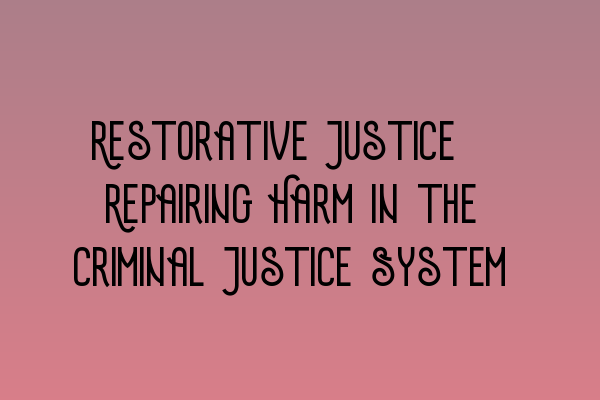Restorative Justice: Repairing Harm in the Criminal Justice System
In recent years, there has been a growing recognition of the limitations of traditional punitive approaches in the criminal justice system. A new philosophy has emerged – one that aims to promote healing and rehabilitation, while also holding offenders accountable for their actions. This approach is known as restorative justice.
Restorative justice focuses on repairing the harm caused by criminal behavior, rather than solely punishing the offender. It emphasizes the needs of the victim, the offender, and the community as a whole. By involving all parties in a facilitated dialogue, restorative justice aims to foster understanding, empathy, and ultimately, resolution.
Within the criminal justice system, restorative justice programs aim to address the root causes of offending behavior and prevent re-offending. Offenders are given the opportunity to take responsibility for their actions and make amends to the people they have harmed. This may involve direct communication or indirect means, such as financial restitution or community service.
Key Principles of Restorative Justice
To better understand the concept of restorative justice, it is important to explore the key principles that underpin this approach:
1. Inclusiveness: Restorative justice recognizes the importance of involving all stakeholders affected by a crime. Victims, offenders, their families, and the community all have a role to play in the restorative process.
2. Dialogue and Participation: Restorative justice encourages honest and open communication between all parties involved. This may take the form of face-to-face meetings, mediated discussions, or written exchanges.
3. Responsibility and Accountability: Restorative justice holds offenders accountable for their actions. Offenders are encouraged to recognize the harm they have caused and take active steps towards making things right.
4. Healing and Rehabilitation: The focus of restorative justice is on promoting healing and rehabilitation. It seeks to address the underlying causes of crime and offer support to both victims and offenders in order to prevent future re-offending.
Benefits of Restorative Justice
Restorative justice has gained popularity due to the numerous benefits it offers to all stakeholders involved:
1. Victim Empowerment: Restorative justice gives victims a voice and allows them to actively participate in the resolution process. This can promote healing, provide closure, and help restore a sense of control and empowerment.
2. Offender Accountability: By holding offenders directly responsible for their actions, restorative justice provides an opportunity for personal growth, empathy development, and an understanding of the harm caused.
3. Community Healing: Restorative justice actively involves the community in addressing and resolving conflicts. By working together, individuals within the community can collectively heal and rebuild trust.
4. Reduced Recidivism: Research has shown that restorative justice programs have a positive impact on reducing re-offending rates. By addressing the underlying causes of criminal behavior, restorative justice offers a pathway towards rehabilitation and successful reintegration.
Conclusion
Restorative justice offers a transformative approach to the criminal justice system. By prioritizing healing, accountability, and rehabilitation, it seeks to repair the harm caused by crime and promote a more inclusive and empathetic society. Embracing the principles of restorative justice can lead to a more just and effective criminal justice system for all stakeholders involved.
